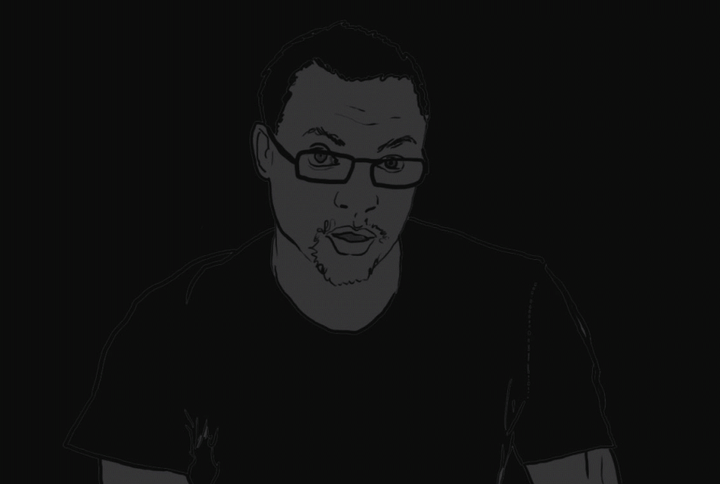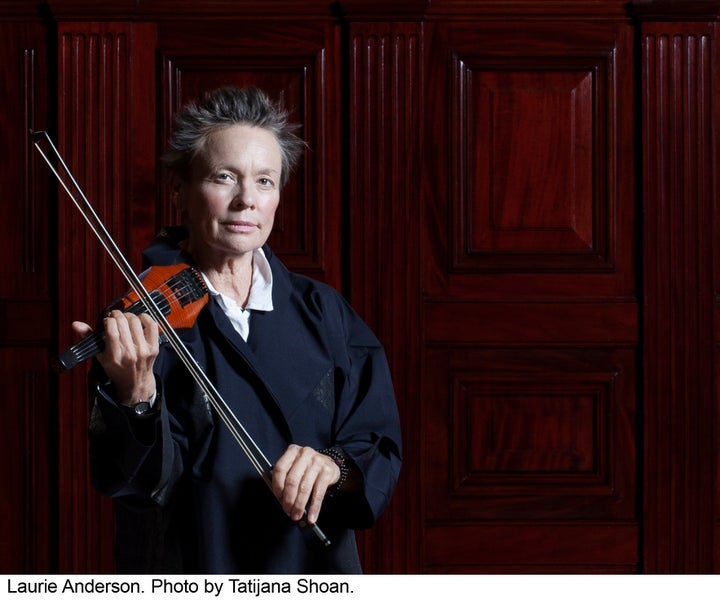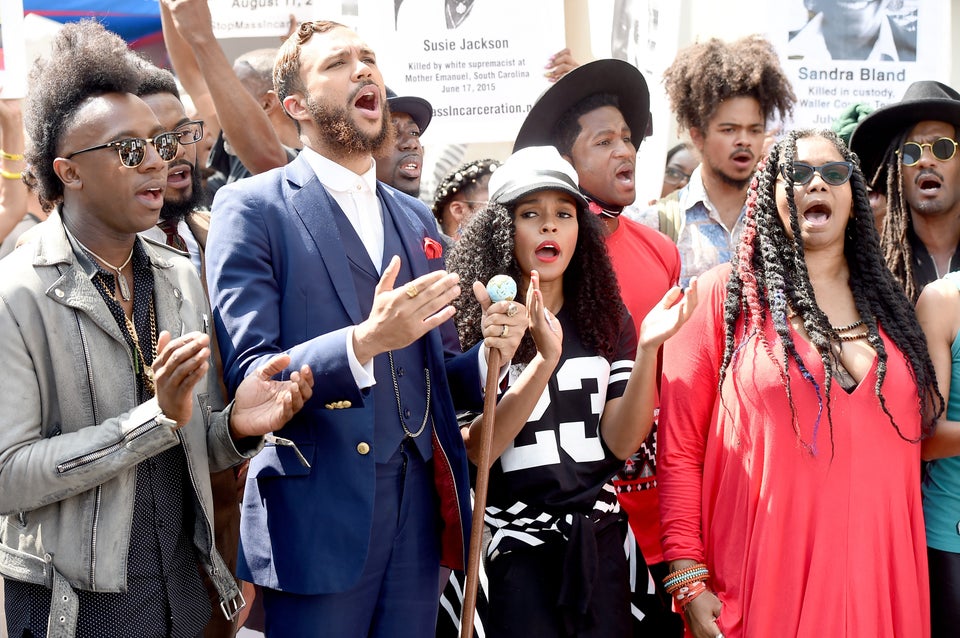
In 2010, artist Marina Abramovic spent six days a week, seven hours a day sitting in a chair in the Museum of Modern Art, silently facing a single viewer sitting across from her, for around 700 hours total. This year, for three days in October, a former Guantánamo detainee named Mohammed el Gharani will sit similarly in a studio in West Africa, where he lives, while his image is streamed straight into another New York City venue, the Park Avenue Armory, for visitors to confront.
Gharani is collaborating with artist Laurie Anderson on a piece entitled "Habeas Corpus," named after the legal action by which detainees can seek relief from unlawful imprisonment. The Latin phrase literally translates to "This is the body." From Oct. 2 through Oct. 4, Gharani's physical body will be in West Africa, but his image will be projected onto a massive body cast sculpture approximating his oversized shape inside the massive Armory drill hall. Gharani, as a former Guantánamo inmate, will never be allowed to enter the United States again. Yet through telepresence, his image can exist where his body cannot.
For the entirety of Abramovic's performance, she sat in silence, making eye contact with each viewer who would sit face-to-face with the artist. For the majority of Anderson's performance, Gharani will sit in silence, inviting viewers to meditate on the relationships between taking time and serving time, absence and presence, what is human and what is inhuman. Approximately once every hour, however, Gharani will tell a story, elaborating on the eight years he spent as one of the youngest detainees in Guantánamo history.
Gharani is one of 15 inmates documented by the Department of Defense as having spent time in Guantánamo Bay while still a child. In total, 775 people have been held captive at the detainment camp. Some have been eventually released without charge, classified onward as "enemy combatants." Others have died in Guantánamo's grip.
As of September 2015, there are 114 people currently detained.
Anderson contacted Gharani through a human rights organization called Reprieve, that works with, among other groups, detainees from Guantánamo. Anderson explained the still-evolving artwork germinating in her mind to Kat Craig, an attorney at Reprieve, and Craig responded that she knew a potential interested subject. That subject was Gharani. In March, they spoke on the phone, a conversation mediated by Craig. In April, they met in person, in Gharani's current home of West Africa.
"The first time I saw [Gharani] was in the gym [in West Africa], when I was doing Tai Chi," Anderson explained in an interview with The Huffington Post. "I was just in the middle of doing this thing called a 19 Form and I was conscious of someone being in the gym, and it was him, and then he just left. Later that day I realized, wow, that was Mohammed."
Gharani was born in Chad, a desert zone in Central Africa. He grew up herding goats with his impoverished family in Saudi Arabia, where he was prevented from studying and treated as an outsider because of his Chadian roots. He was eventually accused of being linked to an Al-Qaeda cell in London in 1998 -- when Gharani was 11 years old and still living in Saudi Arabia. It would be three years later, when he was 14 years old, when Gharani was captured in Pakistan during a raid on a mosque and sent to spend eight years inside Guantánamo's walls.
Now 27, Gharani is a free man living in West Africa. "When he came out he was like where am I?" Anderson said. "He’s been in prison for longer than he’s been released, still."
Upon meeting Gharani for the first time, Anderson was struck by one quality in particular. "Shy," she said. "He was very shy and so was I. It was a shock for me to meet him. I couldn’t get the images out of my head of what had happened to him." Gharani's physical features formed unspoken narratives in themselves. He was missing teeth; his back was injured; his head had been scarred too.
Before long, Gharani began sharing stories with words as well, tremendous stories of his time in Guantánamo Bay, a place that remains for many Americans out of sight, out of mind. A place where there is, in Anderson's words, "an information blackout."
At first, Anderson intended Gharani to remain silent throughout the performance, the thrust of the work coming from the power of his sheer telepresence. However, after hearing his gut-wrenching tales, spoken in English with glints of Caribbean, West African, and Arabic accents shining through, she felt she had to include them in the work. As Anderson explained: "I was the last person who wanted to stop him from talking!"
Storytelling, a common thread throughout Anderson's work, is at the core of "Habeas Corpus." Gharani's stories reference waterboarding, solitary confinement, electroshocks, those brutalities so unspeakable they too often remain cloaked in silence. For Anderson, there stories, and the language in which they are told, can bring truth and liberation.
And yet "Habeas Corpus" also addresses the ways language has been contorted and stretched to construct the very War on Terror itself. Anderson argues, at its nucleus, the War on Terror is nothing but a lattice of stories. "They’re called enemy combatants and then they’re non-persons and then you can do whatever you want to them," she said. "As someone who uses language, I’m fascinated by this insanity."

It's not only language that is yanked from the mouths of the imprisoned and turned against them. It's images as well. Technically, a law dictates that a prisoner, once incarcerated, no longer owns his or her own image. Anderson discovered this law, which she jokingly speculated was left over from the Austro-Hungarian Empire, in the midst of an earlier art project, while attempting to beam the image of a different prisoner into an Austrian church. Eventually the project was cancelled; the prisoner did not own his image and thus no one could use it.
In "Habeas Corpus," Anderson transforms Gharani's image into a means of escape and liberation. In much of Western religion and ancient philosophy, the body is seen as a vessel -- or sometimes a prison -- for the soul inside. Liberation is the soul freed from its physical constraints. For Anderson, it seems that the virtual image is the 21st century means of freedom and escape. If the body is trapped, incarcerated, or banished, telepresence steps in, offering portals to places the soul cannot.
In Anderson's words: "It’s about the transgression of coming back into the United States when you’re not allowed. Through your picture." While for Abramovic, presence -- physical, personal presence -- is the privileged form of being, Anderson offers a plugged-in alternative. Transgression through virtual reality, like a digital apparition.
This magic of transgressing boundaries through images resonates with many other pressing issues related to migration -- specifically, the current refugee crises in Syria and the tragic disappearance of 43 students Mexico. And, of course, those in the United States.
"It was very hard for me to separate [the piece] from real things that were happening," Anderson explained. "Like those two prisoners last year, [David] Sweat and [Richard] Matt, who were on the run from the prison upstate [in New York]. Before they were captured and one was shot, the other inmates were brutalized and beaten; they had bags put over their heads. And I thought, 'Wait a minute! When did we start doing all this stuff like it’s standard treatment?'"
Anderson traces the national numbness regarding brutal punishment of prisoners back to the early days of Guantánamo Bay. "We were told: 'These are the worst of the worst and make them bend over and treat them like dogs.' We did terrible terrible things to these people. It really haunts me. How we got the rights to say they’re nonpersons, has never been described by anyone anywhere. But once they did, they could treat them however they wanted."
Is Anderson's project, in part, an attempt to bring viewers face-to-face with a so-called "non-person" and illuminate his undeniable humanity? Kind of, Anderson says, but not so much. "Not so much as a person," she explained, "but as a presence, a kind of witness. There are a lot of human rights groups who want to show these people as, 'Oh yeah, they’re people just like us. And they’re creative and they write poems!' I’m glad they do but why do we have to make people into palatable versions of themselves? Why do they have to be nice?"
In part, that's why the physical presence of Gharani's streaming sculpture is not quite familiar or palatable, but somewhat uncanny, spooky even. He's not quite a human but a digital witness, oversized and hollowed out. A 21st century spirit returning to tell his tale."It’s really eerie to see a statue speaking," Anderson commented. Anderson describes the body cast sculpture on which his image will be projected as Cubist in style, reminiscent in size and stature, ironically enough, of the Lincoln Memorial.
Yes, Abraham Lincoln, a symbol of American freedom -- who, coincidentally enough, suspended Habeas Corpus for a brief period during the Civil War -- is an unexpected yet strangely relevant figure to draw into the dialogue surrounding the piece.
The fact that Gharani's journey to and from Guantánamo eerily mirrored that of individuals in the 15th century slave trade resonates too. To prepare for their performance, "Mohammed and I went to prisons in West Africa, these holding prisons in castles that had been there for centuries," Anderson said. "Weirdly, it was the same route as the slaves captured in Africa, marched across the continent, kept in these dungeons on the coast, and then shipped to the Caribbean. From Africa to Guantánamo, this was Mohammed’s route as well. I thought whoa, this is a story that has another big picture in it."
Gharani's story overlaps with far more instances of injustice, including racial profiling, police brutality, the role of the camera as a mode of surveillance and a weapon in itself. In a piece Anderson penned about her work for The New Yorker, she expressed: "I just wish Susan Sontag were still around." In her absence, Anderson dips into the powerful and frightfully ambivalent role of the camera amidst violence today. Policemen don them. Drones employ them. Civilians carry them.

Anderson and Gharani worked together for six months creating "Habeas Corpus." During their time together, Gharani spoke of his fellow detainee Shaker Aamer, the final remaining British resident at Guantánamo, brought in on the same airplane as Mohammed over years ago. When Mohammed was released, Shaker was the only one able to wish him goodbye and good luck.
On Friday, September 25, it was announced that Shaker, who has never been charged or put on trial, will be released and returned to the UK. Shaker was detained in 2001 in Afghanistan, suspected of leading an Al-Quaeda cell, though he insisted he was in Afghanistan doing charity with his family. "We talked a lot about Shaker because he was Mohammed's mentor. I haven’t talked to him yet about his release, but I’m sure they will meet soon."
After all that he has endured and all that he has witnessed, Anderson firmly believes that Gharani finally has the chance to tell his story on his own terms. "That really is one of the biggest robberies, as anyone knows who has ever been defined by someone else," Anderson expressed. "Even something like 'you’re so intellectual' -- that becomes your story and you can’t wiggle out of it. He had this story pinned on him that has nothing to do with his life. In this way, he gets to tell his story in print, in projection and in the film. We’re both really, really happy about that."
And despite the unimaginable experience that Gharani was forced to undergo, his story is punctuated with hope and gratitude. "He is a very gentle person. He is somebody who was very clear about the kindness of some of the guards. Some people, at considerable risks to themselves, were kind to him. He knows he can’t make generalizations about huge groups of people, that’s what this is about. We’re not trying to define everybody in some big, giant group. Over here are terrorists, over here are good citizens. It’s super complex and he knows that."
His views on America are similarly nuanced and generous. "After all of this, he loves American comedians. He loves American culture. He would like to come here and visit."
Abramovic's "The Artist is Present" offered a powerful and simple mode of engagement -- the human gaze -- as a somewhat idealistic opportunity for understanding, empathy, connection. Don't bother with screens and texts and virtual in-betweens, the work says, look into the eyes of another person.
Anderson's "Habeas Corpus" operates differently. Certain images deserve to be seen. Certain stories deserve to be told. Not all of those who house said stories are able to meet up in the lobby at the MoMA. While Abramovic's iconic performance strips away the excess, Anderson invites everything in. Every complexity, every historical overlap, coincidence or something more. Telepresence reigns supreme, able to surpass physical laws and limits like a supernatural power. Anderson acknowledges the camera, the virtual image, the story, as powerful tools capable of both truth and lies, art and violence.
From October 2 through October 4, however, she presents them as art.
"Habeas Corpus" is part of the Park Avenue Armory Programing. Buy tickets here.
Also on HuffPost:

